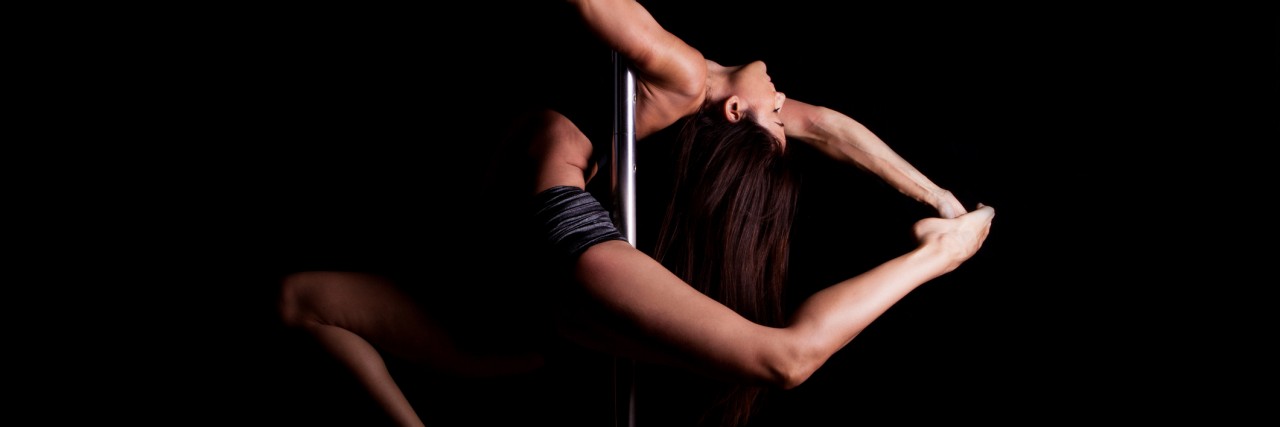OK, let’s start with the stereotypical image of a pole dancer: a tall, slight woman with the right curves in all the right places and amazing boobs. She’s able to rock huge heels and amazing hair while doing an awe-inspiring routine without looking like she’s broken a sweat.
Now let’s discuss body dysmorphia. The NHS defines it as an anxiety disorder that causes a person to have a distorted view of how he or she looks and to spend a lot of time worrying about his or her appearance. For example, a barely visible scar is a major flaw that everyone is staring at or, as it was for me, the person could be a of small build and tiny figure yet perceive herself as much bigger, seeing someone of a much greater size and weight when she sees a reflection or looks down at her own body.
Body dysmorphic disorder (BDD) is estimated to affect up to one in every 100 people in the U.K. The condition can affect all age groups, but usually starts when a person is a teenager or a young adult, when people are generally most sensitive about their appearances. It’s more common in people with a history of depression or social phobia. It often occurs alongside obsessive-compulsive disorder (OCD)or generalized anxiety disorder, and may also exist alongside an eating disorder, such as anorexia or bulimia.
Some of the most common behaviors of people with BDD include:
- constantly comparing their looks to other people’s
- spending a long time in front of a mirror, but at other times avoiding mirrors altogether
- spending a long time concealing what they believe is a defect
- becoming distressed by a particular area of their body (most commonly their face)
- feeling anxious when around other people and avoiding social situations
- being very secretive and reluctant to seek help because they believe others will see them as vain or self-obsessed
- seeking medical treatment for the perceived defect – for example, they may have cosmetic surgery, which is unlikely to relieve their distress
- excessively dieting and exercising
After all that, does it see plausible for someone with BDD to also be a pole dancer? To me, not really, but here I am proving myself wrong.
Let’s start with these characteristics:
Constantly comparing their looks to other people’s
Spending a long time in front of a mirror, but at other times avoiding mirrors altogether
A pole dance studio is usually the same as any dance studio, full of mirrors — floor-to ceiling-mirrors — so you can see how moves look and whether you’re straight or not. Not the ideal situation for those wanting to avoid their appearance at all costs. Also many pole dancers fit the expected norm of body type, so it’s easy to stare and criticize yourself.
Becoming distressed by a particular area of their body (most commonly their face)
Feeling anxious when around other people and avoid social situations
Pole dancing typically requires as much “flesh” to be available as possible, leaving little to be hidden. It’s not exactly easy with a room full of people, mirrors and minimal clothing to exactly be at peace with the body area you want to hide. Also, pole dancing is a lot more popular than you might think! Classes filled to their max, along with full shows, isn’t exactly the quietest setting. In fact it’s quite the opposite.
By all logic, BDD and pole dancing just should not work, but they do! While I cringed at every reflection I saw and every pair of eyes on me in that room, as soon as I was on that pole, a freedom would come over me. It’s hard to explain how being in minimal clothing surrounded by people all staring at the things I hated gave me the most confidence I’d ever experienced.
While writing this I’ve questioned myself multiple times. How I’ve managed to get through those doors on a weekly basis and see my reflection everywhere I looked and still get on that pole like I’d never had a doubt in the world about myself is beyond me. All I know is the small time on the pole being confident and free is worth the agonizing time spent looking into or avoiding mirrors for the rest of the lesson.
Image via Thinkstock.

